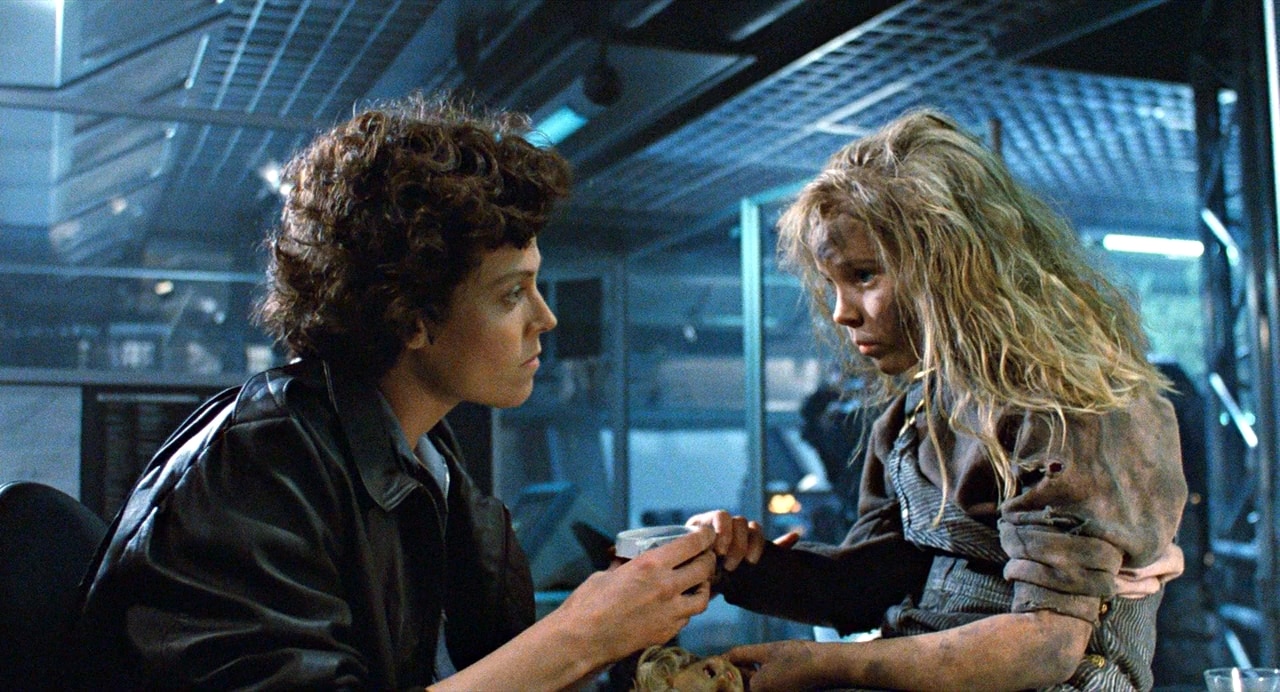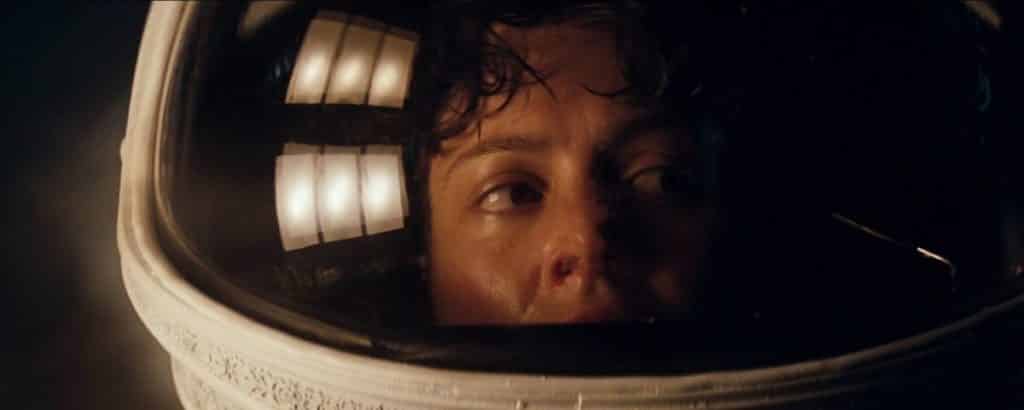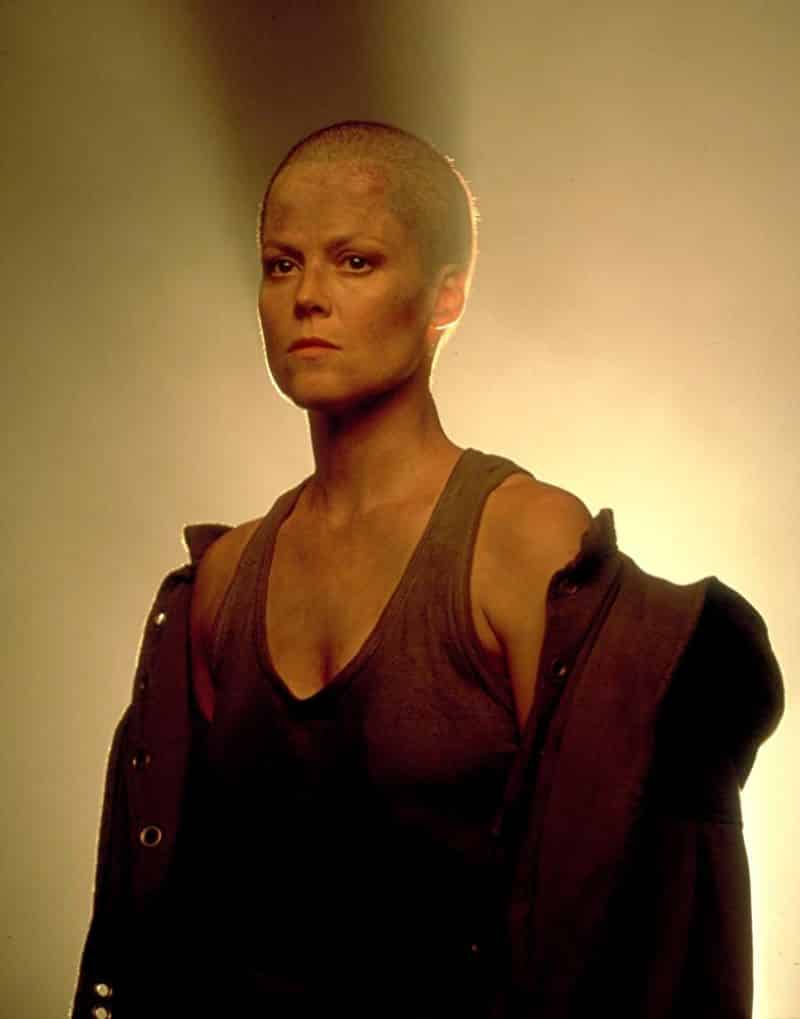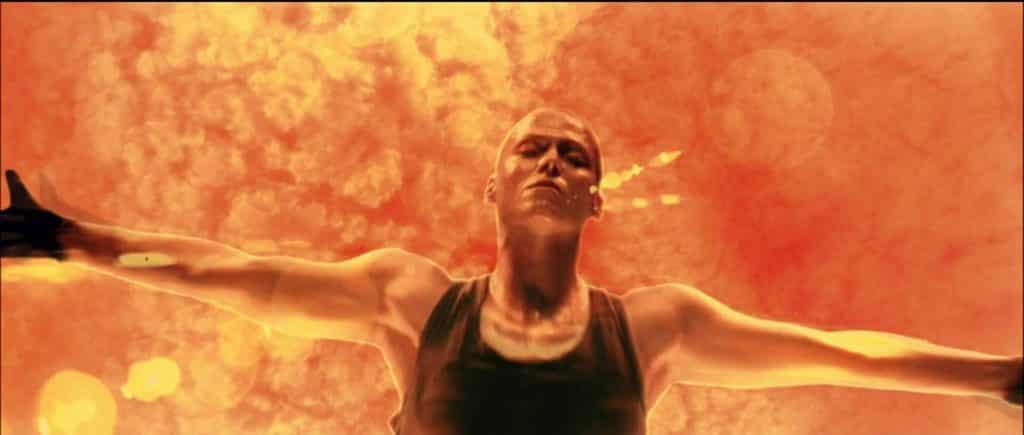
Ellen Ripley, played by Sigourney Weaver, is the heroine of the first three entries in the Alien Franchise: Alien, Aliens, and Alien 3. In this essay, we will discuss Ellen Ripley’s identity and how it changed based on the needs of each film and the franchise as a whole.
Warning: This essay contains spoilers for Alien, Aliens, and Alien 3.
(Note: To maintain a clear view of her overall character arc, I have decided to only cover the films in which Ellen Ripley canonically appears. Thus, I will not be discussing Alien: Resurrection in this essay.)
Ellen Ripley: Final Girl
“Final report of the commercial starship Nostromo, third officer reporting. The other members of the crew – Kane, Lambert, Parker, Brett, Ash, and Captain Dallas – are dead. Cargo and ship destroyed. I should reach the frontier in about six weeks. With a little luck, the network will pick me up. This is Ripley, last survivor of the Nostromo, signing off.”
– Ellen Ripley, Alien
On paper, Alien is very simple, even formulaic. It features a likeable-if-unruly gang of characters as they come face to face with a murderous entity, which picks them off one by one. Alien improves on the formula by painstakingly constructing an atmosphere of tension and suspense, building genuine investment in the characters, and rewarding the viewer with huge, gruesome payoffs. Make no mistake, quality does not determine genre. Alien is still a slasher film at heart. And in a slasher film, the characters have only one goal: survival.
The 1970’s saw a Renaissance in horror films, and during this time, many common horror tropes were established. One of the most prominent of these tropes is the “Final Girl”. Texas Chainsaw Massacre (1974) is often cited as one of the first slasher films. It is arguably the first example of the Final Girl trope, inflicting immense pain and suffering on the female protagonist, Sally. By virtue of her perseverance through emotional torture, the script grants her a reprieve, and she escapes from Leatherface and his family relatively unharmed. John Carpenter’s 1978 classic Halloween focuses heavily on virgin Lori Strode. It sharply contrasts her behavior with the other teens in the film, inviting the audience to empathize almost exclusively with her. Lori survives her encounter with Michael Myers not with skill or strength, but by sheer force of will.

The 1980’s would see a huge boom in slasher films, such as Friday the 13th, A Nightmare on Elm Street, Halloween II (which gave Lori a backstory tying her to Michael Myers and cementing her Final Girl status in the franchise), My Bloody Valentine, Prom Night (also starring Jamie Lee Curtis, the original Scream Queen), and many more. These films and others like them codified the slasher film and cemented the Final Girl as a staple of the horror genre.
The Final Girl trope is not an exact science, and there are plenty of exceptions and subversions. Notably, The Cabin in the Woods not only utilizes this device but also comments on it, claiming (in a speech delivered by Sigourney Weaver) that the Final Girl is part of a larger, cosmic plan, which is only served if horror archetypes suffer and die in the correct order. In Scott Glosserman’s 2006 indie film Behind the Mask: The Rise of Leslie Vernon, a documentary crew follows a horror film serial-killer-to-be as he prepares for the “big event”. The serial killer explains to the interviewer that the Final Girl is his adversary, that she is necessary to his story, that her struggle completes his mission.

Ellen Ripley makes her first appearance in the 1979 film Alien. She is the Security Officer on the commercial ship Nostromo, third in command after Dallas and Kane. When the Nostromo intercepts a distress signal (or a warning) from a nearby moon, the crew is prematurely awakened from stasis to investigate. Dallas, Kane, and Lambert investigate the planet and find no answers as to the source of the signal. What they do find is an abandoned ship and a dormant organism, which awakens and attaches itself to Kane, clamping onto his face and wrapping its tail around his neck.
Dallas and Lambert bring Kane back to the ship and insist that he be brought to the med bay immediately. Ripley refuses, citing a mandatory 24-hour quarantine. Dallas attempts to pull rank on Ripley, ordering her to open the door. Ripley shows empathy for Dallas’ situation, but she refuses again. This tells us everything we need to know about Ellen Ripley: 1) She is intelligent. 2) She is competent. 3) She is not controlled by her emotions. It’s not that she doesn’t care about Kane. She just understands that her duty to herself and the rest of the crew is more important than her duty to one man.
Ash, the Science Officer, ignores Ripley and lets Dallas, Lambert, Kane, and the alien onto the ship. Kane lays unconscious for a short while, with the creature inextricably attached to his face. Eventually, the creature lets go and seems to die. Kane is free and comes to. Everything seems to be back to normal. But an insidious alien embryo gestates in Kane’s body, and that night, at dinner, it bursts from his chest.
One by one, the crew members are picked off by the alien (Xenomorph) until only Ripley remains. She sets the ship to self-destruct and attempts to flee, unaware that the alien has stowed itself aboard the escape pod with her. Feeling safe for the first time since Kane’s attack, Ripley strips down to a shirt and the world’s smallest underwear. She has never been more vulnerable. As she is setting up her stasis pod, the alien reveals itself. In a final act of courage, she grits her teeth, singing “You are my lucky star” under her breath, as she climbs into a spacesuit, straps herself into a chair, and opens the airlock, shooting the monstrosity into space and incinerating it with the escape pod’s jets.
Ellen Ripley is not a traditional Final Girl. She is not a virgin, she is not a teenager or college student, and she has far more skill and intelligence than most horror heroines. But most importantly, Ripley isn’t “special.” The first hour of the film grants her equal screen time with the rest of the crew. She has no special powers nor does she share any affinity with the Xenomorph. Sigourney Weaver is not even given first billing in the credits. The lone survivor could have been any one of the crew. But it also feels like, no matter how many times the dice were rolled, it was always going to be Ripley. She is the Final Girl because she is a Survivor.
Ellen Ripley: Mother
“Get away from her, you bitch!”
-Ellen Ripley, Aliens
Aliens is regarded as one of the best sequels of all time, with some even arguing that it is superior to the first entry. It features more aliens, and of course, more deaths. Upping the ante this way is a common tactic in horror sequels, especially in slasher films. However, it should be done with care.
How many horror franchises have been derailed by a string of increasingly ridiculous deaths in an effort to maintain viewer interest? How many horror franchises are forced to delve into self-parody to stay relevant? Aliens wisely avoids this trap by shifting the genre. It is no longer a slasher film, instead focusing on the horrors of war, notably using Vietnam imagery to evoke a very different, but equally effective response in the audience.
The 1980s not only saw a rise in the slasher genre, but in sci-fi and action as well. And with James Cameron at the helm of action sci-fi in the late 80s and early 90s, audiences were given two female icons in quick succession: Ellen Ripley in 1986’s Aliens and Sarah Connor in 1991’s Terminator 2: Judgement Day. Both women were defined by their status as Final Girls in their film debuts and by their role of Mother in their respective sequels.
The Mother is another common female archetype in horror films. Rosemary’s Baby, for instance, is about a great many struggles faced by women: infidelity, gaslighting, abuse, and of course, pregnancy. This is the Mother as Victim. She is defined by the tortures she endures. Carrie features the Mother as Villain, a common trope in which the child must destroy an overbearing matriarch. In other films like The Others, The Babadook, and Hereditary, the Mother is a more complex figure, an exploration of grief and despair. These mothers often pose a threat to their own children, and must defeat their own inner demons to achieve redemption.
It is rare in horror films for the Mother to be depicted as the Hero. She is often a victim or an antagonist, occasionally a protagonist, but rarely a hero. This is where Ellen Ripley and Sarah Connor shine. They are kick-ass mothers, not to be underestimated or coddled.
In Aliens, Ellen Ripley is awakened to find out that she has been drifting through space in stasis for 57 years. She discovers that her daughter, Amanda, who was 10 years old when Ripley left, died at the age of 66; two years before she was rescued. Ripley is stripped of her rank and given a menial job at the cargo docks. Meanwhile, corporate benefactor Weyland-Yutani has established a colony on LV-426, the same moon visited by the Nostromo 57 years before. But it isn’t long before things go wrong. Weyland-Yutani loses contact with the colonists, and Ripley is enlisted as a consultant to accompany a squad of Colonial Marines with a mission to exterminate the alien threat.
When they arrive, the marines find no trace of the colonists save one, a little girl named Newt, whose family has been killed by the aliens. Ripley immediately takes the girl under her wing, cleaning her up, soothing her, and gaining her trust. They bond over their mutual loss and need for companionship. Newt tells Ripley that she is afraid to sleep because she always has nightmares, and Ripley promises that she will never let any harm come to her.
The majority of the marines are killed during an ill-advised firefight right next to the nuclear reactor for the facility. The station becomes a ticking time bomb. Then the aliens slowly pick off the rest throughout the course of the movie until only Ripley, Newt, Hicks, and Bishop remain. They hatch a plan to escape, but complications arise when Hicks is injured, and Newt is taken by the aliens. Only Ripley can save Newt from a fate worse than death.
She ventures into the depths and finds Newt, only to come face to face with the Alien Queen. The Queen is a giant, monstrous creature, and she lays egg after endless egg, each one ready with a Face Hugger inside. This places Ripley, the surrogate mother of Newt, in direct conflict with the Queen herself as they both try to protect their children. Mother vs. Mother.
Ripley dons a mechanized suit of armor used for cargo loading, allowing her to withstand the mighty blows of the Alien Queen. Through sheer force of will, not just for herself, but on behalf of her new daughter, Ripley is able to defeat the Queen. Newt runs into Ripley’s arms, crying, “Mommy!” Ripley puts Hicks, Bishop, Newt, and herself into stasis, assuring Newt that they can both finally dream without worrying about nightmares. Ripley is no longer the Final Girl. She has saved her child. She has saved her friends. She is not just a Survivor, but a Protector.
Ellen Ripley: Martyr
“I keep telling you I want to die!”
-Ellen Ripley, Alien 3
This is where things get complicated. The smashing success of Aliens was a tough act to follow. After years of rewrites and production hell, Alien 3 was finally released to a chorus of disappointment, apathy, and even anger. It made a lot of bold choices, some of which may have worked in a more consistent film, and others which were probably doomed from the start. A young and untested David Fincher was brought on to direct, and filming began before the script was even finished. The story featured a more introspective look into faith and sacrifice. This was a hard pivot from the franchise’s slasher roots. However, it also provided a fitting end for the character of Ellen Ripley.
The word “martyr” can be defined in a few ways. In this analysis, we will use martyr in its loosest sense, to mean a person who sacrifices something of great value (usually their life) for the sake of faith or principle. The story of the Martyr is popular in all genres of film. Many writers and directors purposefully create films that mirror the story of Jesus Christ to add gravitas and pathos to their pieces. Man of Steel and The Matrix, for example, both utilize Christ and martyr imagery in an effort to humanize and deify their heroes.
Horror films have a more interesting relationship with the Martyr. Self-sacrifice is a common theme in horror films, but the circumstances around the sacrifice are rarely holy in nature. Instead, the horror film Martyr is cursed. The curse may come from a classic deal with the devil, as in Faust, or it may come from the hubris of man, like Dr. Frankenstein. The curse may stem from vengeful spirits, as we see in Poltergeist, or it may be the result of curiosity, as in Hellraiser.

Usually, the curse takes a more physical form; that of a demon, ghost, or monster possession. In these films, the protagonist (or a suitable replacement) must either be exorcised or sacrificed for the benefit of all. This tried and true story can be seen in a plethora of horror films such as Evil Dead (2013), Drag Me to Hell, A Nightmare on Elm Street 2, The Shining, The Amityville Horror, and dozens (if not hundreds) more. Whether or not the sacrifice is voluntary determines if the hero can be considered a Martyr. It also often determines whether or not the protagonist is successful in destroying the evil inside of them.
Alien 3 begins with a short, nightmarish montage over the credits. We see a Face Hugger latched onto one of the survivors, an explosion, the ejection of Ripley’s stasis pod, and the eventual crash landing of the entire stasis unit onto Fiorina “Fury” 161, a correctional facility planet populated only by men.
When Ripley is awakened, she learns that everyone from the previous mission has died, including Newt. She pleads with the facility’s doctor, Clemens (played by Charles Dance), to do an autopsy on the child. Clemens eventually relents, but they find no hint of a xenomorph inside of her body.
Meanwhile, a dog has been attacked by a Face Hugger and implanted with a new alien. The alien bursts from the dog, fully formed, and wreaks havoc on the relatively peaceful prison population. After the sudden death of Dr. Clemens at the hands of the dog-xenomorph, Ripley realizes that she is housing an Alien Queen within her, granting her immunity from the alien threat. She pleads with one of the prisoners, Dillon, to kill her but is eventually convinced to lead the hunt for the creature, with the understanding that he will kill her immediately after they have destroyed it.
The xenomorph is lured into the blast furnace, drowned in hot lead, and doused in cold water, which finally kills it. Ripley then comes face to face with a man who looks exactly like Bishop, an emissary from Weyland-Yutani. He promises her that he will remove the Alien Queen inside of her and destroy it. She considers for a moment and then lets herself fall backward into a vat of hot lead. As the alien bursts forth from her chest, she clutches it to herself, like a mother would a child, her face serene, and they are both engulfed in flames.

In Alien 3, Ripley takes on the roles of holy martyr and cursed martyr, an innocent possessed by a demon, fated to destroy her own body for the sake of all others. The film makes no qualms in comparing Ripley to Jesus Christ. In the scene where she pleads with Dillon to kill her, she spreads her arms across the iron bars of his prison cell as if awaiting crucifixion. The conversation with Bishop II at the end was likely inspired by The Last Temptation of Christ, in which the devil, disguised as an angel, tempts Jesus in his last moments, offering him an end to his suffering. Ripley is similarly tempted by a devil in disguise, but she chooses death over the comfortable lies of the Company.
In this movie, nothing is sacred. The off-screen death of Hicks, the autopsy of Newt, and the resurrection of Bishop are purposefully profane. The film asks us to imagine what it would be like to have your identity ripped away time and again, to constantly struggle for your life, to find that everyone you’ve ever loved is gone, every life you’ve ever saved has been cut short, every sacrifice you’ve ever made has been meaningless. Ellen Ripley is a woman to be idolized, but never envied. And so it is that Ripley, the Hero, the Final Girl, the Mother, the Martyr, the focal point for so much suffering, finally meets her end with what can only be described as relief.
Final Thoughts:
Ellen Ripley is one of the greatest heroines in all of film history. Her intelligence, strength, and compassion have inspired people from all walks of life for the last 40 years. We see ourselves in Ripley, in her tenacity, her vulnerability, her unflinching courage in the face of overwhelming odds. The legacy of Ellen Ripley goes beyond a few horror films. She is an icon. One that will continue to inspire generations to come.




1 comment on “Alien and the Evolution of Ellen Ripley”
Comments are closed.